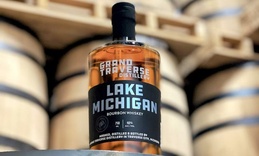
Inhabitect Is Bringing Nature Home
How a northern Michigan company is greening the Great Lakes Region
By Matt Dursum | May 10, 2025
Green infrastructure and ecological landscaping are coming to northern Michigan thanks to the team at Inhabitect. The full-service firm started in 2013 with a mission to design, build, and grow living architecture, natural shorelines, and green stormwater infrastructure.
“I went to school for landscape architecture at Michigan State, and I jumped right into the green roof industry at its infancy in North America,” says Nathan Griswold, the founder of Inhabitect.
After over eight years working as the Senior Garden Roof Technical Sales Coordinator for American Hydrotech, a global leader in green roof manufacturing and waterproofing, it was time for the next challenge, this time in northern Michigan. “I wanted to come home to Traverse City, where I grew up, and so I started Inhabitect.”
Griswold’s work took him around the world, from the centuries-old cities of Europe to the innovative urban landscapes of South America. “I routinely think about how I’ve seen things in Mexico and South America. They’re blending green infrastructure really nicely, but so do major metropolitan areas,” says Griswold.
Although green architecture and environmentally conscious landscaping are in their infancy, Griswold saw more and more cities take on the practice.
“A lot of it happens in the older cities, even smaller cities like Philadelphia and Washington, DC, and around the Chesapeake Bay; they’re doing a lot of great work there and managing stormwater before it hits the bay. This is something the community could be doing more of here in the Grand Traverse Bay watershed. Inhabitect works hard every day to do our part.”
Green Roofs and Rain Gardens
For the first few years Up North, Griswold and his team focused on building green roofs for homes and businesses throughout Michigan. Then they switched gears.
“I quickly found a need and a desire to do ground-level landscaping, and so we came off the rooftops and started to do eco-friendly landscaping and natural shorelines and other types of habitat projects—pollinator gardens and landscapes using mostly native plants,” he says.
Inhabitect designs and builds projects around the state, from Detroit to the Mackinac Bridge. Besides private residential and commercial projects, the team works with nonprofits, such as the Conservation Resource Alliance and Watershed Center in Traverse City, and local tribal entities.
Recently, the team has been working with the Bay Mills Indian Community in Brimley, Michigan. “We’re creating rain gardens that are going to have plants that are not only medicinal, but they’re also for ceremonial and other cultural uses,” says Griswold.
As more people and businesses see the value in sustainable green infrastructure and architecture, the company is growing its design department. Soon, the team will not only design the landscapes, create land use plans, and green-ify rooftops, but also lay out the buildings themselves.
“Inhabitect can help you lay out an entire property, or a multi-site development, and help you pick where the homes are going to go, the sun and shade conditions of the site, as well as what the homes will look like,” says Griswold. Customers will receive help through permitting, design, construction, landscaping, and stormwater management.
To help with the expansion, Griswold’s team now consists of a large group of talented individuals from multiple disciplines.
“We’re a very diversified team,” says Griswold. Inhabitect includes a director of operations, multiple operations managers, landscape designers, site supervisors, and a team with experience as contractors and builders, many of whom with a background in landscaping, horticulture, engineering, architecture, and landscape architecture. “We even have a chef who used to work at a Michelin-star restaurant that’s on our team.”
Also on the team is an FAA-certified drone pilot. “We fly drones on almost every project to document existing conditions, do site analysis, and deep design analysis,” says Griswold. With drone technology, the team can monitor sites and projects and collect data on the broader environmental impact and report it via GIS (geographic information systems) mapping.
Stormwater Treatment and Native Plantings
For local homes and businesses, there are many incentives to designing and building green infrastructure and natural ecosystems within our urban environments.
“Having green infrastructure, plants, and green spaces is healthier for humans. Humans are scientifically proven to be happier when they’re around a lush landscape versus concrete or blacktop,” says Griswold.
Inhabitect incorporates several key design elements to create functional and eco-minded landscaping that will last generations. First, the team focuses entirely on using native plant species. According to Griswold, deeply rooted native species such as yarrow, asters, and perennial flowers work as buffers for runoff coming from lawns, parking lots, and urban structures.
This is all part of what landscape architects call the stormwater treatment train.
“The stormwater treatment train is basically managing water at multiple levels throughout a site. From the rooftop down the side of the building, maybe it’s collecting in the green wall and running to the sidewalk, where the permeable pavement is letting water go through it underground, maybe infiltrating into the ground itself, or being piped over to a rain garden,” says Griswold.
Each stage helps slow and cool the water before it enters the Great Lakes watersheds and local waterways.
“By slowing water down and cooling it, we’re not affecting the wildlife around the river, stream, or lake,” says Griswold. “If the water is too warm, trout won’t be able to live. And if a trout isn’t able to live, blue herons have nothing to eat; so it’s all part of an ecosystem that we’re trying to make more resilient by using those plants in our landscapes versus making an environment that’s sterile of any wildlife.”
One of the goals the team has for their sites is to create thriving ecological transition zones between the buildings and the natural world. Transition zones encourage biodiversity by providing resources and shelter for many species of animals. Native perennials and flowers attract more pollinators and beneficial wildlife to built spaces.
Besides being good for the planet, these spaces are cheaper to maintain because they remove the need for excessive fertilizing, regular mowing, and expensive landscaping maintenance.
According to Griswold, green infrastructure, permeable pavements, green roofs, green walls, natural shorelines, and rain gardens will have long-lasting impacts on our communities. “Inhabitect is creating places where nature is more accessible to all. These spaces are resilient, functional, and more aesthetically pleasing.”
Learn more about Inhabitect’s offerings at inhabitect.com.
Trending

Three Holiday Shopping Sprees (and Trees!)
Head north of the 45th parallel this weekend for three chances to get all your holiday shopping done weeks before you’… Read More >>
Writing a Heartfelt Card
They say that letter writing is a lost art, but Thrive 45° Young Professionals Group and the Petoskey Chamber are hoping… Read More >>
Distillery Ups and Downs of 2025: Craft Spirits Industry Is Shifting, but Not Shaken
In late October, scores of people bellied up to the bar to sample a variety of spirits made at Northern Latitudes’ new… Read More >>


